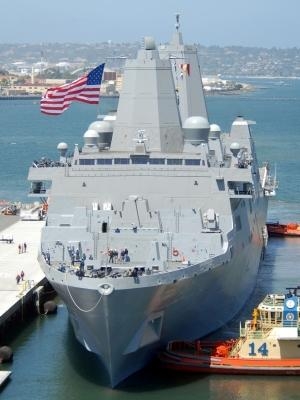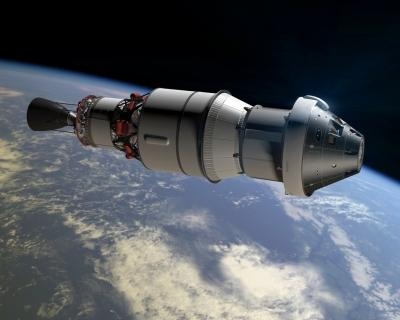Orion Will Splash Down Off The Coast Of California In January If All Goes According To Plan
Senior project managers from NASA managing the Orion spacecraft's Exploration Flight Test (EFT-1) visited San Antonio-class amphibious transport dock ship USS San Diego (LPD 22), Sept. 12 in preparation for a test to retrieve the Orion space capsule in January off the coast of Southern California. NASA representatives met with Rear Adm. Frank Ponds, commander Expeditionary Strike Group (ESG) 3 and Capt. William R. Grotewold, the ship's commanding officer to discuss plans for the upcoming recovery mission.

"We had a chance to display the ship's capability, show the crew's enthusiasm and demonstrate that our amphibious capability is multi-dimensional - just one more thing that our Navy can do," said Ponds. "The LPD 17-class ships have one of the most robust command and control communications systems in our Navy inventory."
The uncrewed EFT-1 flight will take Orion to an altitude of approximately 3,600 miles above the Earth's surface,, After the test flight, Orion will reenter the atmosphere at a speed of more than 20,000 miles per hour, returning to Earth faster than any current human spacecraft. Orion will land in the Pacific, where the U.S. Navy will locate and recover the craft into the ship's well-deck. The test flight is intended to test the capsule's avionics, heat shield and parachutes. "It's all about relationships, to make sure our priorities are the same and clearly everyone is on the same page and we're excited about it," said Mark Geyer, NASA Orion program manager. "This ship that is going to support our mission possesses an incredible capability."
NASA and the Navy have a long history of working together, notably with the recent stationary recovery of Orion in the well-deck of the USS Arlington (LPD 24) while berthed at Naval Station Norfolk's Pier 12 Aug. 15. "NASA did a trade study whether they wanted Orion to land on the ground or in the water," said Andy Quiett, Detachment 3 deputy operations lead for the Orion program and DoD liaison for NASA, "and because of the size, weight and the deep space requirements of the vehicle, they determined it needed to land in water."

Orion's unique life support, propulsion, thermal protection and avionics systems enable extended duration for deep space missions with the goal to eventually land on Mars. "We are working hard to go to Mars and EFT-1 is our first step in that direction," said Dan Dumbacher, deputy associate administrator for NASA's exploration systems. "EFT-1 will be the furthest we've sent a human spacecraft since our moon travels in 1972, so we need to get the design experience, we need to get the test experience and we need to get the operations experience such as the recovery operations that we're looking at here."
EFT-1 is to be the first of many such future recovery missions. "It's important to participate in an event that's bigger than us," said Grotewold. "This is going to go on for the entire life of this ship and to be able to get in on the ground floor for something like this in an awesome opportunity for all of us."
ESG 3 and USS San Diego operate within Third Fleet's area of responsibility.
(USS San Diego image provided by the U.S. Navy. Orion image provided by NASA)
ANN Salutes Mass Communication Specialist 3rd Class Corey T. Jones, Commander, U.S. 3rd Fleet Public Affairs
 ANN's Daily Aero-Term (05.05.24): Omnidirectional Approach Lighting System
ANN's Daily Aero-Term (05.05.24): Omnidirectional Approach Lighting System Aero-News: Quote of the Day (05.05.24)
Aero-News: Quote of the Day (05.05.24) Airborne 05.06.24: Gone West-Dick Rutan, ICON BK Update, SpaceX EVA Suit
Airborne 05.06.24: Gone West-Dick Rutan, ICON BK Update, SpaceX EVA Suit Airborne 05.03.24: Advanced Powerplant Solutions, PRA Runway Woes, Drone Racing
Airborne 05.03.24: Advanced Powerplant Solutions, PRA Runway Woes, Drone Racing Aero-News: Quote of the Day (05.06xx.24)
Aero-News: Quote of the Day (05.06xx.24)




